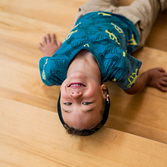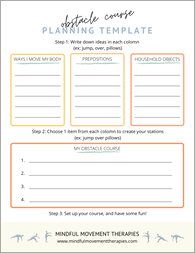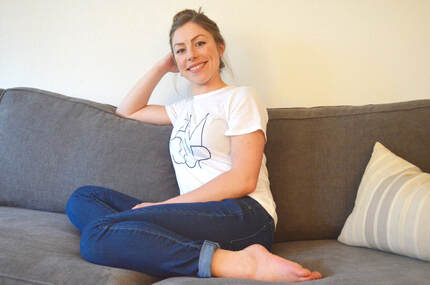|
Why should you care about obstacle courses?
Obstacle courses provide a fun way to promote praxis, a sensory-based process that involves ideation (forming an idea of something to do), motor planning (planning how to do it), and execution (carrying out the plan). Having a child build and move through their own obstacle course strengthens these skills many times over. But, creating an obstacle course can be a difficulty task for many kids. Especially those with some challenges with executive functioning. Here are some thoughts on how to help your child organize and set up their ideas… 1. Print out our planning template.
2. Help your child make a list of ways to move: examples include step, walk, creep, crawl, army crawl, scoot, roll, jump, hop, leap, run, tiptoe, gallop, skip, or animal walks (like bear crawl, crab walk, frog jump).
3. Help your child make a list of prepositions: examples include up, down, into, onto, between, under, over, through, across, around, behind 4. Then, help your child make a list of objects. Examples include:
5. Plan the course by mixing and matching the above lists. If your child is old enough to write it out, practice some handwriting. If not, draw step-by-step pictures as they plan their course. For example:
6. Set up the course for execution. You can do so in a linear fashion, or circular. Let the kids help, as the heavy work of lifting, carrying, pushing, and pulling materials into place is built in OT. Use of various household materials reinforces tactile discrimination. Stretching and contracting muscles develops body awareness, and proprioception. Balance and moving through space in varying positions/directions develops vestibular function. Negotiating around obstacles and perceiving spatial relationships improves motor planning, coordination, and postural responses. It is such a rich learning activity. I hope you have fun!
0 Comments
Your comment will be posted after it is approved.
Leave a Reply. |
meet the bloggerAusten is a pediatric occupational therapist with experience in schools, early intervention, and private clinic settings. She now runs her own private practice in Portland, OR specializing in movement based learning techniques. This blog's mission is to educate and empower parents and children by sharing insights into the complexities of learning and development. Categories
All
|
MINDFUL MOVEMENT THERAPIES
In-Home Pediatric Occupational Therapy in Portland, Oregon
phone503-720-4634
|
|
|




